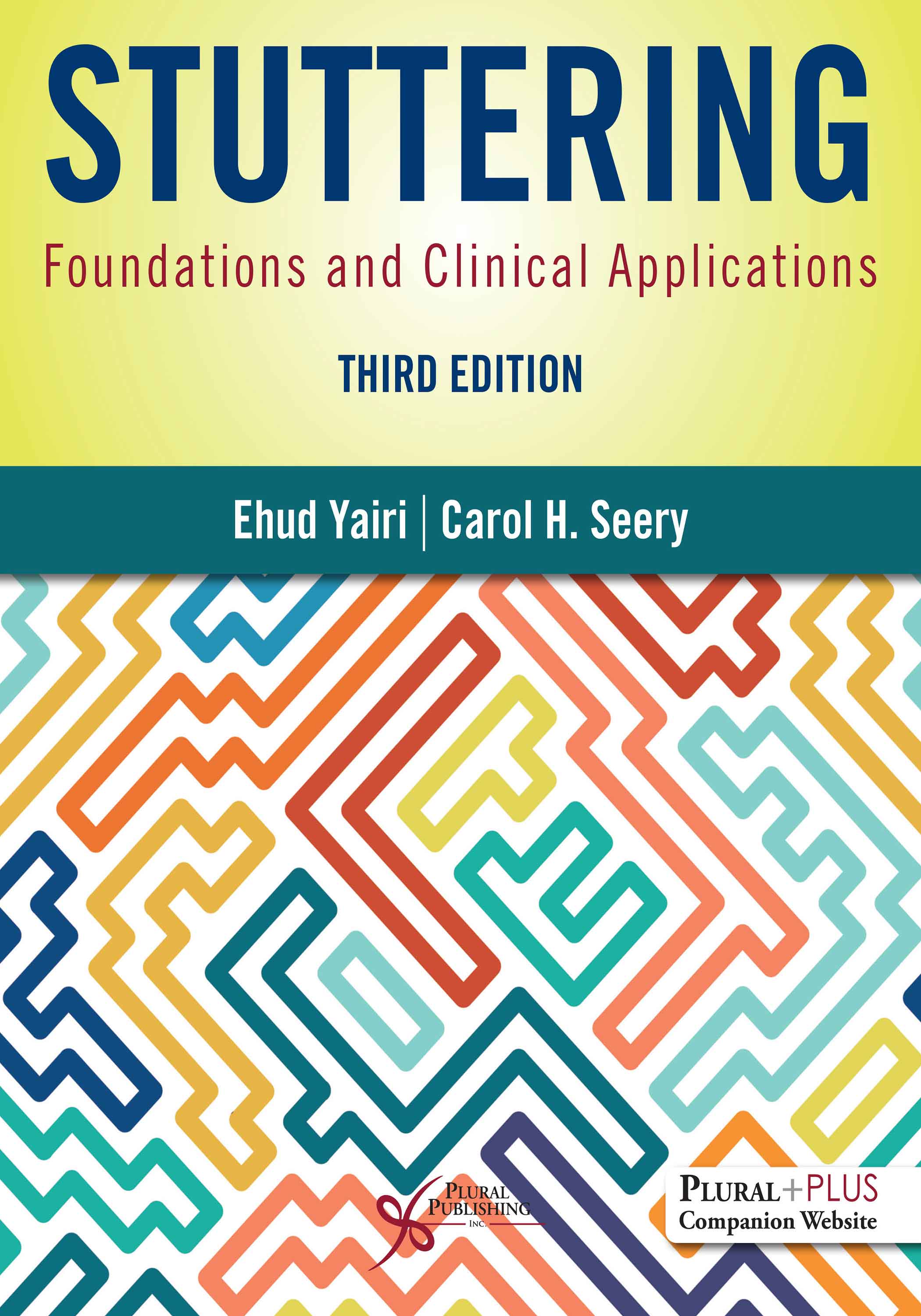
Stuttering: Foundations and Clinical Applications.
Third Edition
Ehud Yairi, Carol H. Seery
Details: 465 pages, B&W, Softcover, 8.5" x 11"
ISBN13: 978-1-63550-355-5
© 2023 | Available
For Instructors
Purchase
A New Edition is Coming in September!
Stuttering: Foundations and Clinical Applications, Third Edition presents a comprehensive overview of the science and treatment of stuttering in a single text. The book offers a unique level of coverage of the stuttering population, the disorder’s features, and the therapies offered for different ages. Written for both undergraduate and graduate level audiences, the authors guide students to critically appraise different viewpoints about the nature of stuttering, understand the disorder’s complexities, and learn about the major clinical approaches and therapies appropriate for different age groups.
This evidence-based textbook is divided into three distinct sections. Part I, Nature of Stuttering, offers descriptive information about stuttering, including its demographics and developmental pathways. Part II explores the various explanations of stuttering, giving students an understanding of why people stutter. Part III focuses on clinical management, delving into the assessment of both adults and children, as well as various age-appropriate intervention approaches. In the final chapter, the authors explore other fluency disorders, as well as cultural and bilingual issues.
New to the Third Edition
- Significantly updated scientific information and references
- Content has been edited, shortened, and simplified to be more concise and reader-friendly
- A PluralPlus companion website with ancillary materials for instructors and students
Key Features
- Each chapter begins with a list of learner objectives to frame the chapter before new material is presented
- Boxes throughout the text and bolded words are used to highlight important points
- End-of-chapter summaries and study questions allow readers to review and test their understanding
- Infused with suggested further readings and websites
- Included visuals, tables, diagrams, photos, and drawings help clarify and expand on key concepts
- Numerous case studies and testimonies from parents in the text with additional cases on the book’s companion website
- Bolded key terms throughout with a comprehensive glossary to improve retention of the material
Reviews
“…The purpose of the third edition is to provide an all-encompassing textbook that covers the nature of stuttering, a review of the theories and explanations of the disorder, and a practical guide for clinicians in evaluating and treating stuttering at various ages. The book is a comprehensive representation of the complexities of the disorder and includes clear explanations of how to provide supportive services, depending on the needs of the person who stutters (PWS). Stuttering modification, fluency shaping, and instrumentation are described to guide therapy. Clinicians in the field, as well as students preparing their skills, will appreciate the well-described steps in implementing therapy tasks.
This updated edition remains targeted to undergraduate and graduate students, as well as speech-language pathologists working with children and adults. The comprehensive nature of the discussions allow this to be a stand-alone, required text for a fluency course at either the undergraduate or graduate level… Extensive investigations are presented throughout the chapters, covering historical studies and current research…
One feature that is valued when reading through the various psychological and neurophysiological theories is the discussion of clinical implications and strengths and weaknesses of the theories presented. Readers gain a reflective understanding that drives application of therapy intervention. The authors present case studies along with descriptions of cluttering, neurogenic, and psychogenic stuttering, which help provide guidance for differential diagnosis and treatment of related disorders. Throughout the book, the authors refer back to previous discussions, helping the readers understand the continuity of learning between topics. Each chapter ends with thought-provoking discussion questions and suggested readings that can be used for self-reflection, class assignments, or group interaction. Website links are provided in print for many of the chapters. These same websites are available on the companion website, which is granted to students and instructors for supplementary material.
This book is a detailed representation of stuttering that considers scientific evidence, ethical considerations, and age-related evaluation and treatment considerations. The authors thoughtfully discuss foundational topics such as the complexities of stuttering when defining the disorder, as well as deep examinations of theories and models that drive therapeutic intervention… this outstanding textbook is invaluable. Research in the area of stuttering is continually being updated, thus, there is validation for the authors to provide a relevant resource. Beyond current research that is presented, they identify aspects within the topic of stuttering that have been inconclusive and need to be more fully researched for speech pathologists to gain a fuller understanding of the disorder and its impact on intervention. Overall, this book is a phenomenal resource for professors, students, and speech pathologists wanting to gain a complete understanding of stuttering, impacting those from preschool through adulthood.”
–Darcie Beth Hultberg, BA, MS, Biola University, from Doody’s Reviews (August 2022)
“…As was the case in previous versions, the book is intended for students in the field of speech-language pathology and related fields as a single main text for a general course on stuttering… Stylistically, the book is more reader friendly and has been edited to abbreviate certain sections while maintaining the key content. It also contains new visuals, pictures, diagrams, and tables, and overall has a better flow than previous editions. It contains features such as learner objects at the start of each chapter, boxes that highlight key points, end-of-chapter summaries and study questions, suggestions for further reading and websites, case studies and parent testimonials, and a comprehensive glossary.
Another nice feature for instructors is the PluralPus companion website that contains a lot of useful content and is a big improvement from previous editions… I was particularly happy to see the addition of videos of people stuttering in different languages and severity levels, as well as videos of ameliorating factors. This content will be a great help for students and instructors and this alone is reason enough to strongly consider adopting the book for a class.
Part I of the book focuses on the “Nature of Stuttering” and includes four chapters that discuss topics like terminology, definitions, symptoms, incidence and prevalence data, research on onset and development, and other factors related to the epidemiology of stuttering…
Part II of the book discusses “Explanations of Stuttering” including three chapters discussing theories and models of stuttering. I particularly enjoyed Chapter 5 which deals with how to evaluate theories and models. I believe that chapter helps set the stage for the critical thinking students need for evaluating the assertions contained in the various theories described later. This chapter is another example of what sets this book from some others. The authors discuss the need for an integrated framework of stuttering and, very importantly, distinguish between different levels of causation including predisposing, precipitating, and perpetuating causes… I enjoyed how the authors discuss weaknesses and potential clinical implications of the theories they describe to make it clear how one’s theory for what causes stuttering influences how it is managed clinically.
Part III of the book focuses on “Clinical Management of Stuttering.” This section starts with two chapters on assessment (one focusing on adults and school-age children, the other on pre-school children). The content in these chapters is thorough and the authors do a nice job linking the epidemiological research reviewed earlier in the book to assessment factors relevant for pre-school children… I also appreciate how the authors describe methods and procedures for assessment of physical speech disruption as well as assessment of social, emotional, and cognitive factors. In doing this, they clinically operationalize their view that stuttering is a multidimensional condition in the context of carrying out an assessment.
…The book closes with Chapter 15, which focuses on a variety of topics including other types of fluency disorders and cultural and bilingual issues. This is another strong chapter that presents a variety of helpful information on topics that have perplexed many speech-language pathologists including neurogenic stuttering, psychogenic stuttering, and cluttering… Overall, the third edition of “Stuttering: Foundations and Clinical Applications” by Ehud Yairi and Carol H. Seery is a textbook packed with valuable information about stuttering and other fluency disorders. It balances information on research, theory, and clinical management, has been updated with new and important research findings since the last edition, and includes a more reader friendly style and flow. A large quantity of helpful supplemental instructor and student resources are available as well. Ultimately, I highly recommend that instructors of classes covering fluency disorders consider adopting this book as a primary text for their students. The book is certainly appropriate as a main textbook for graduate students learning about fluency disorders, perhaps with the addition of supplemental readings on topics such as those I have recommended in this review. Certain portions of the book would also be useful for undergraduates in courses focused on stuttering, although the book strikes me as more appropriate for graduate study. I have enjoyed reading the previous editions of this book, and this newest edition is the strongest yet. I appreciate the authors’ efforts and their hard work in writing, revising, and updating this book for the important purpose of better educating our students, and professionals (current and future) on the disorder of stuttering and its clinical management.”
–Michael P. Boyle, PhD, CCC-SLP, Montclair State University, from the Journal of Fluency Disorders (2022)
Part I. Nature of Stuttering
Chapter 1. What Is Stuttering?
Defining Stuttering: Bases and Aims
Why is the Definition Important? Practical Implications
Population Identification
Quantification and Measurement
Clinical Decisions
What to Define: Atypical (Abnormal) Speech or Complex Disorder?
Stuttering as Atypical Speech
Normally Fluent Speech Production
Normal Disfluency or Instances of Stuttering?
Speech-Oriented “Definitions”
Examples of Stuttering Denoting Speech Events
Fluent Speech of People Who Stutter
Stuttering as a Complex Disorder
Multidimensional Characteristics of the Stuttering Disorder
Disorder-Oriented “Definitions”
Examples of Stuttering Denoting Complex Disorder
Other Views
Our Point of View
Summary
Study Questions and Discussion Topics
Websites
Suggested Readings
Chapter 2. Who and How Many Stutter?
Incidence and Prevalence
Interpretation of Incidence and Prevalence Data
The Significance of Incidence and Prevalence
Implications for Research and Theory
Implications for Professional Training
Implications for Clinical Service Delivery
Implications for Public Awareness and Funding
Research Methodology for Incidence and Prevalence
Approaches to Prevalence Research
Approaches to Incidence Research
Defining Stuttering
Selecting Informants
Prevalence: Findings
Early Investigations
Later Research
Incidence: Findings
Biological Factors in Stuttering Incidence and Prevalence
Familiality
Age
Gender
Geography, Race, and Culture
Geography
Race
Culture
Bilingualism
Prevalence in Clinical Subpopulations
Hearing Impairment
Cleft Palate
Cognitive Impairment
Other Groups
Summary
Study Questions and Discussion Topics
Websites
Suggested Readings
Chapter 3. When and How Does Stuttering Begin? How Does It Develop?
Theoretical and Clinical Significance
Onset
General Issues and Research Methods
Studies Concerning Onset
When Does Stuttering Begin?
How Does Stuttering Begin?
Features of Early Stuttering
Emotional and Physical Health
Phonology and Language
Development
Historical Perspectives on Developmental Progression
Differential Developmental Progressions
Natural Recovery
The Statistical Evidence
Retrospective Evidence
Indirect Longitudinal Evidence
Direct Longitudinal Evidence
Implications of Developmental Findings
Predictive Factors
Summary
Onset
Development
Study Questions and Discussion Topics
Suggested Readings
Chapter 4. Where Does Stuttering End? What Are Its Advanced Characteristics?
Advanced Stuttering
Speech Disfluency
Types of Disfluency
Major Disfluency Classes
Dimensions of Disfluency
Physical Concomitants
Other Speech Characteristics
Voice
Speaking Rate
Emotional Characteristics and Cognition
Emotional Reactions
Cognition
Concomitant Disorders
The Dynamics of Advanced Stuttering
Patterns of Occurrence
Loci of Stuttering
Conditions That Diminish Stuttering
Conditions That Increase Stuttering
Summary
Study Questions and Discussion Topics
Suggested Readings
Part II. Explanations of Stuttering
Chapter 5. Why Do People Stutter? Evaluating Theories and Models
Theories and Models
How to Analyze a Stuttering Theory
Science, Superstition, and Stories About Stuttering
The Need for an Integrated Framework
Criteria for Strong Theories and Models
Testing Theories and Models
Are There Stuttering Subtypes?
Summary
Study Questions and Discussion Topics
Suggested Readings
Chapter 6. Is Stuttering Psychological? Theories and Investigations
Is Stuttering Psychological?
Psychoemotional Theories
Psychoanalytic Theory
Alternative Views of Psychoemotional Disturbance
Personality Factors in Stuttering
Summary of Psychoemotional Theories
Psychobehavioral Theories
Stuttering as a Reactive Avoidance Behavior
Stuttering as a Conditioned Anxiety Response
Stuttering as an Operant Behavior
Two-Factor Theory of Stuttering
The Demands-Capacities Model
Summary of Psychobehavioral Theories
Psycholinguistic Theories
Psycholinguistic Processes Resulting in Fluent Speech
Psycholinguistic Factors in Stuttering
A Theory of Covert-Repair?
The Fault Line Hypothesis
Related Areas of Research
Summary of Psycholinguistic Theories
Summary
Study Questions and Discussion Topics
Suggested Readings
Chapter 7. Is Stuttering Biological? Theories and Investigations
Introduction
Genetic Perspectives
Familial Incidence
Twin Studies
Family Aggregation
Biological Genetics
Neurological Perspectives
Cerebral Hemispheric Dominance
The Modern Era of Brain and Other Neurological Research
Summary of Neurological Perspectives
Auditory Perspectives
The Role of Audition
Summary of Auditory Perspectives
Physiological and Motor Perspectives
Motor Learning Theories of Stuttering
Brainstem Reflexes: A Disorder of Movement
Sensorimotor Dysfunction
Multifactorial Theory from a Motor Perspective
Evidence of Motor Differences
Summary of Physiological and Motor Perspectives
Summary
Study Questions and Discussion Topics
Suggested Readings
Part III. Clinical Management of Stuttering
Chapter 8. Assessment of Adults and School-Age Children
General Considerations
Assessment of Stuttering
Special Considerations for School-Age Children
Assessment Objectives
Background and Case History
Observations and Examinations: Speech
Speech Sample Context
Speech Sample Size
Measures of Stuttering or Disfluency
Speech Recordings and Transcription
Procedures for Speech Sample Analysis
Disfluency Reference Data
Severity of Stuttered Speech
Physical Concomitant
Speaking Rates
Voice and Other Communication Skills
Affective and Cognitive Domains
Situational Rating Protocols
Attitude Rating Scales
Interpretations and Treatment Recommendations
Diagnosis
Treatment Recommendations
The Diagnostic Report
Summary
Study Questions and Discussion Topics
Suggested Readings
Chapter 9. Assessment of Preschool-Age Children
Challenges, Objectives, and Settings for the Initial Evaluation
Stuttering versus Normal Disfluency: A Diagnostic Challenge
Other Key Diagnostic Issues
Objectives of the Initial Evaluation
Setting and Preparation
The Case History
Case History Form: Preschool Children
Collecting Clinical Data
Obtaining Speech Samples
Other Related Assessments
Analyzing Clinical Data
Disfluency Frequency and Types
Disfluency Length
Speech Rate
Interpreting Clinical Data
Disfluency Status
Stuttering Severity
Borderline Cases
Making Prognosis
The Illinois Prediction Criteria
Concluding Parent Conference
Diagnosis, Prognosis, and Recommendations
Parent Counseling
Summary
Study Questions and Discussion Topics
Suggested Readings
Chapter 10. Stuttering Therapy Overview: Issues and Directions
Introduction
Theoretical Considerations
The Objectives of Therapy
Increased Fluency
Managed Stuttering
Improved Cognitive-Emotional Adjustment
General Therapeutic Approaches
The Client-Clinician Relationship
Empathy
Self-Congruence
Unconditional Positive Regard
Clinical Applications
Developing Appropriate Treatment Objectives
Individual Versus Group Therapy Sessions
Implementing Treatment
Skill Maintenance and Prevention of Relapse
Evidence-Based Practice
A Case Study to Illustrate the Steps in EBP
Clinical Research
Evaluating Efficacy
Group Studies
Single-Subject Studies
Issues Regarding Clinical Efficacy
Ethics
Questions Concerning Ethics
Summary
Study Questions and Discussion Topics
Suggested Readings
Chapter 11. Therapy for Adults: Focus on Emotional Reactions
Adults Who Stutter
Treatments
Psychotherapy and Relaxation
Psychoanalysis
Rational-Emotive Therapy
Relaxation
Summary of Psychotherapy and Relaxation
Desensitization
Systematic Desensitization
Desensitization in Vivo
Desensitization to Stuttered Speech
Desensitization to Listeners
Summary of Desensitization
Mindfulness Therapy; Acceptance and Commitment Therapy
Assertiveness Training and Group Therapy
Assertiveness Training
Group Therapy
Summary of Assertiveness Training and Group Therapy
Antianxiety Drugs
Why Drugs?
Drugs for What?
Studies of Pharmaceutical Treatments for Stuttering
Summary of Antianxiety Drugs
Summary
Study Questions and Discussion Topics
Websites
Suggested Readings
Chapter 12. Therapy for Adults: Focus on Stuttering and Fluency
Introduction
Identification
Rationale
Phase I: Awareness
Phase II: Analysis
Summary of Identification
Modification
Step I: Post-Block Modification
Step II: In‑Block Modification
Step III: Pre-Block Modification
Summary of Modification
Fluency Oriented Therapies
Fluency-Focused Therapy Basics
Rhythmic Speech
Slow Stretched Speech
Behavioral Reinforcement
Summary of Fluency-Focused Therapies
Fluency-Inducing Instruments
Metronome Pacing of Speech
Auditory Masking
Altered Auditory Feedback
Biofeedback
Summary of Fluency-Inducing Instruments
Integrated Approaches
Internet, Mass Media-Based and Teletherapy
Summary
Study Questions and Discussion Topics
Suggested Readings
Chapter 13. Therapy for School-Age Children
School-Age Children Who Stutter
Awareness and Emotional Reactions
Overt Stuttering
Academic Performance
The School and Home Factors
The Age Factor
Prognosis and Objectives for Therapy
Why Is Stuttering in School-Age Children Difficult to Treat?
Therapy Alternatives and Objectives
Home and School Environments
Counseling Parents
Teachers and Peers
Therapy: Explaining Stuttering
The Speech System
What Can Go Wrong with the Speech System?
Experimentation
Therapy: Focus on Emotional Reactions
Adapted Desensitization Activities
Assertiveness, Resilience, Teasing
Bullying
Therapy: Focus on Stuttering and Fluency
Identification and Analysis
Changing Speech
Stuttering Modification
Fluency Facilitating Speaking Skills
Generalization
Other Therapy Programs
Conditioning Fluent Speech
Family Stuttering Programs
Group Therapy
Clinical Research
Summary
Study Questions and Discussion Topics
Websites
Suggested Readings
Chapter 14. Therapy for Preschool-Age Children
General Considerations
A Brief Historical Review
Direct Treatments
Indirect Treatments
Winds of Change
Current Issues Concerning Early Intervention
Factors Pertaining to Stuttering
Factors Pertaining to Age
Who Should Be Treated? When?
Current Therapies
Focus on Learning Principles
Focus on Parent-Child Interaction
Focus on Speech/Motor Patterns
Focus on Emotionality
Clinical Research
Past and Current Research
Weaknesses and Other Issues in Research
General Reflections
Summary
Study Questions and Discussion Topics
Websites
Suggested Readings
Chapter 15. Other Fluency Disorders; Cultural and Bilingual Issues
Introduction
Childhood Disorders
Unusual Breathing Patterns
Word-Final Disfluency
Language Disorders
Cluttering
Acquired Stuttering
Neurogenic Stuttering
Psychogenic Stuttering
Malingering
Stuttering in Bilingual and Multicultural Populations
Incidence
Diagnosis
Treatment
Summary
Study Questions and Discussion Topics
Websites
Suggested Readings
References
Index
Stuttering: Foundations and Clinical Applications, Third Edition comes with access to supplementary student and instructor materials on a PluralPlus companion website.
STUDENTS:
To access the student materials, you must register on the companion website and log in using the access code printed on the inside front cover of your book.
INSTRUCTORS:
To access the instructor materials, you must contact Plural Publishing, Inc. to be verified as an instructor and receive your access code.
Email: instructormaterials@pluralpublishing.com
Tel: 866-758-7251 (toll free) or 858-492-1555
*Note for students: If you have purchased this textbook used or have rented it, your access code will not work if it was already redeemed by the original buyer of the book. Plural Publishing does not offer replacement access codes for used or rented textbooks.
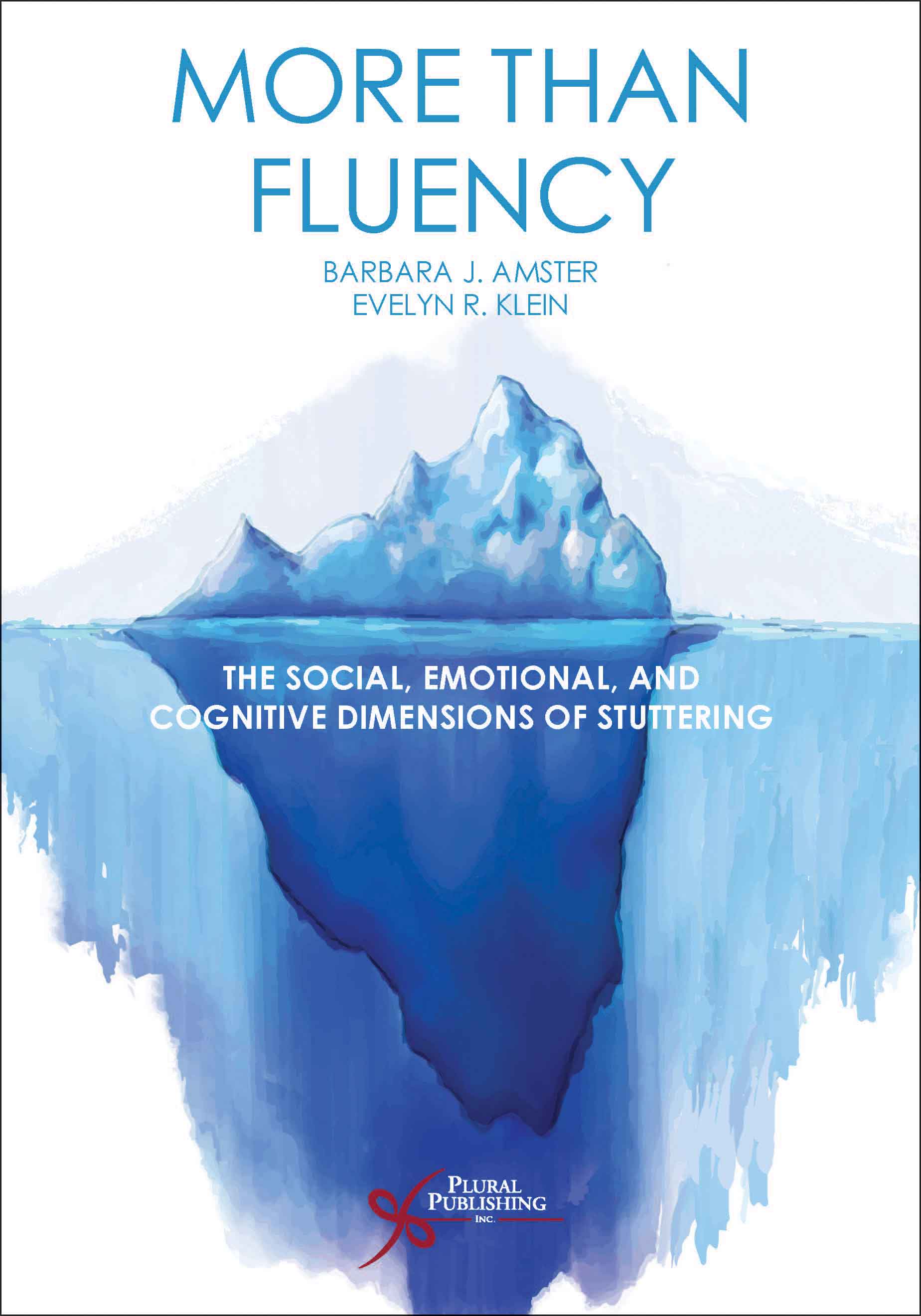
More Than Fluency: The Social, Emotional, and Cognitive Dimensions of Stuttering
First Edition
Barbara J. Amster, Evelyn R. Klein
Details: 242 pages, B&W, Softcover, 7" x 10"
ISBN13: 978-1-59756-995-8
© 2018 | Available
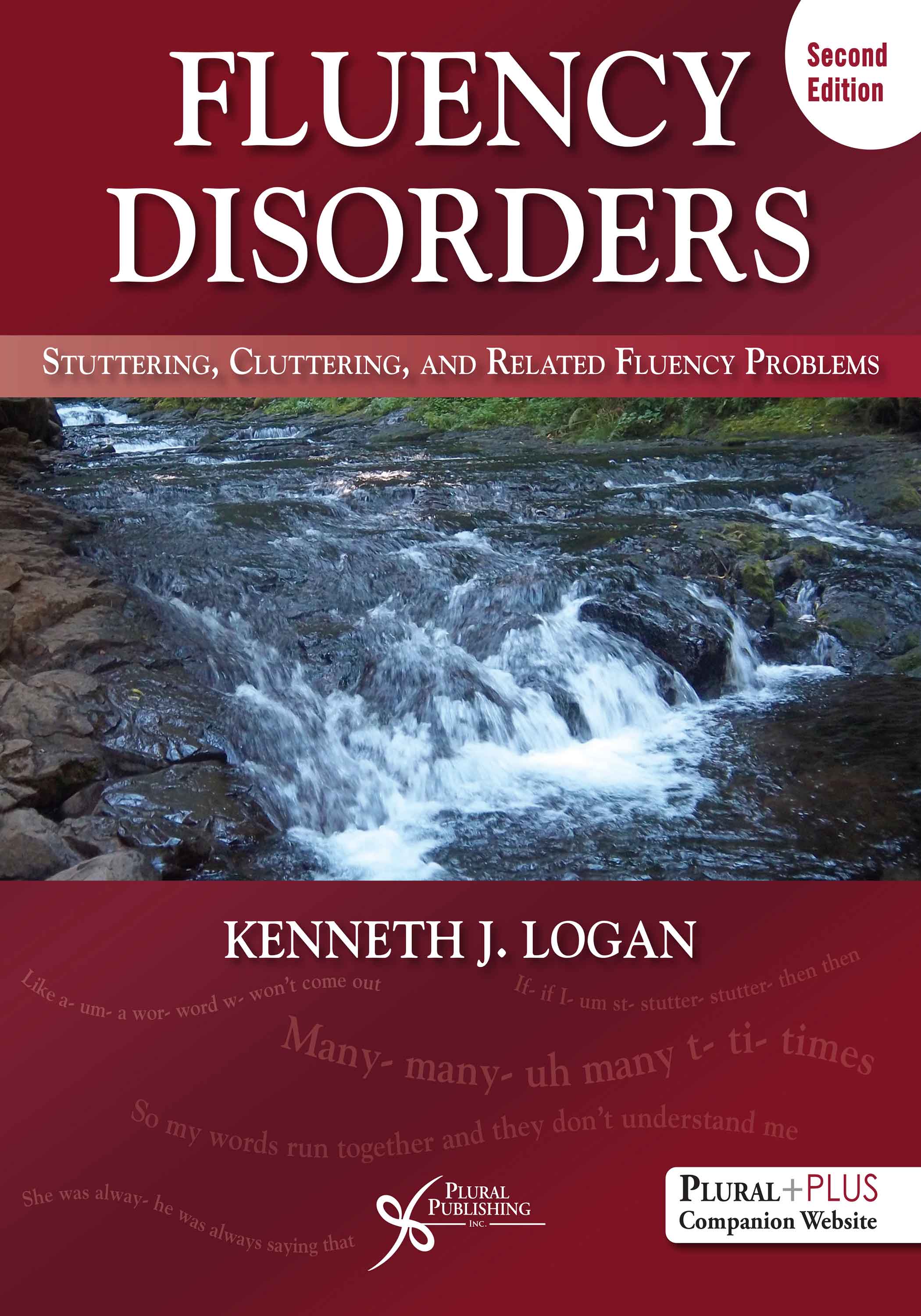
Fluency Disorders: Stuttering, Cluttering, and Related Fluency Problems
Second Edition
Kenneth J. Logan
Details: 609 pages, B&W, Softcover, 8.5"x11"
ISBN13: 978-1-63550-147-6
© 2022 | Available
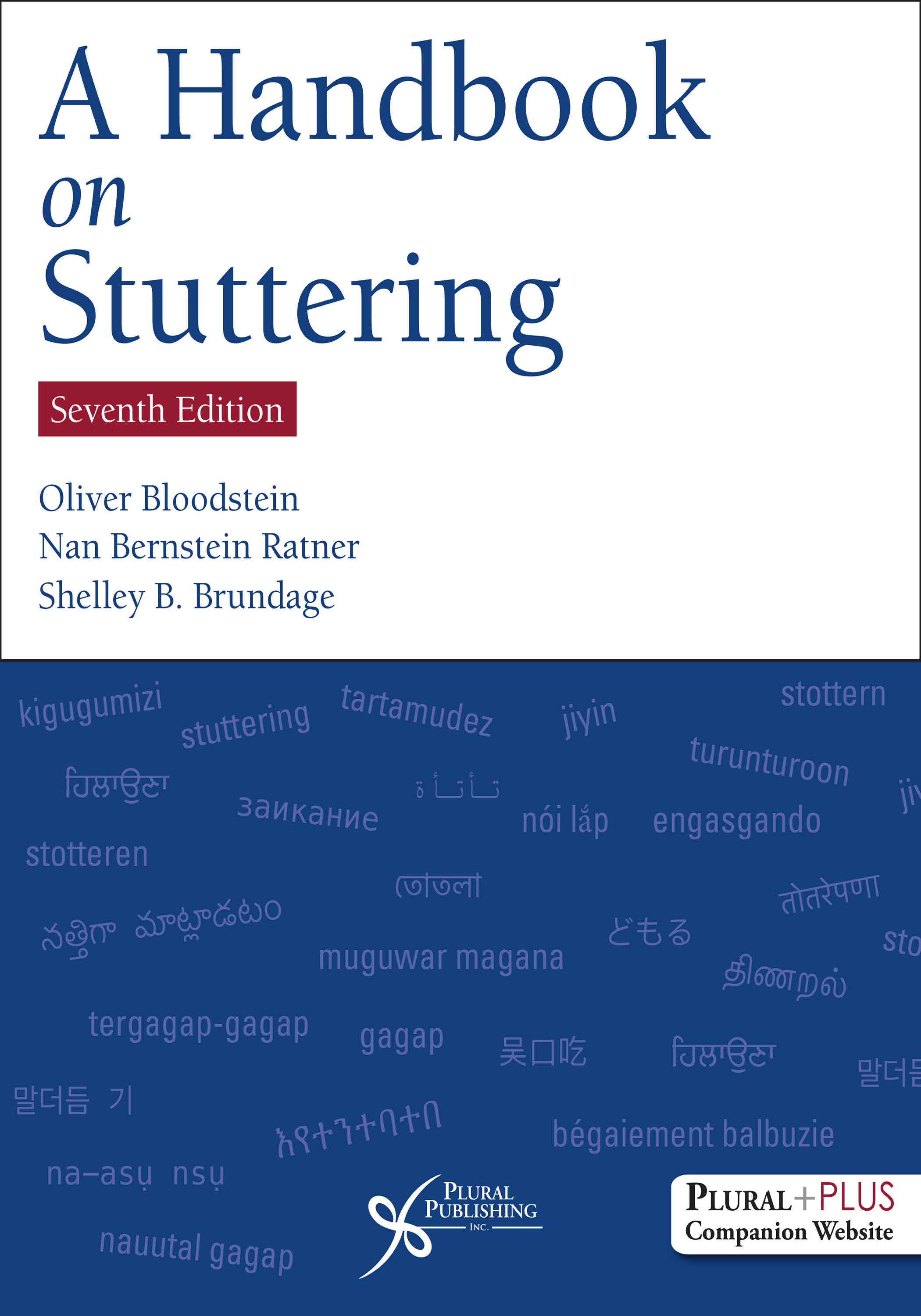
A Handbook on Stuttering
Seventh Edition
Oliver Bloodstein, Nan Bernstein Ratner, Shelley B. Brundage
Details: 581 pages, B&W, Hardcover, 8.5" x 11"
ISBN13: 978-1-63550-317-3
© 2021 | Available
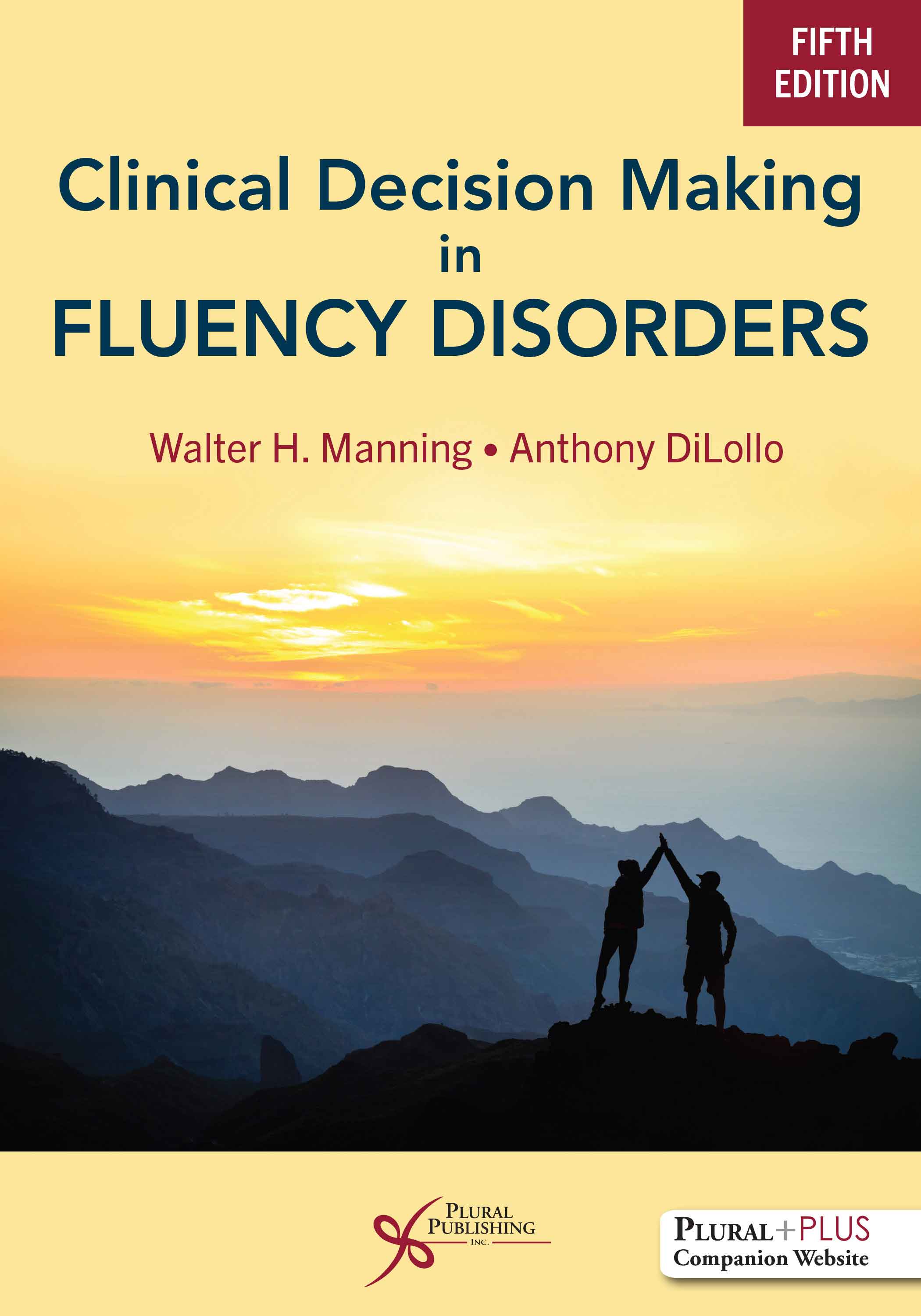
Clinical Decision Making in Fluency Disorders
Fifth Edition
Walter H. Manning, Anthony DiLollo
Details: 580 pages, 2-Color, Softcover, 7" x 10"
ISBN13: 978-1-63550-633-4
© 2025 | Available
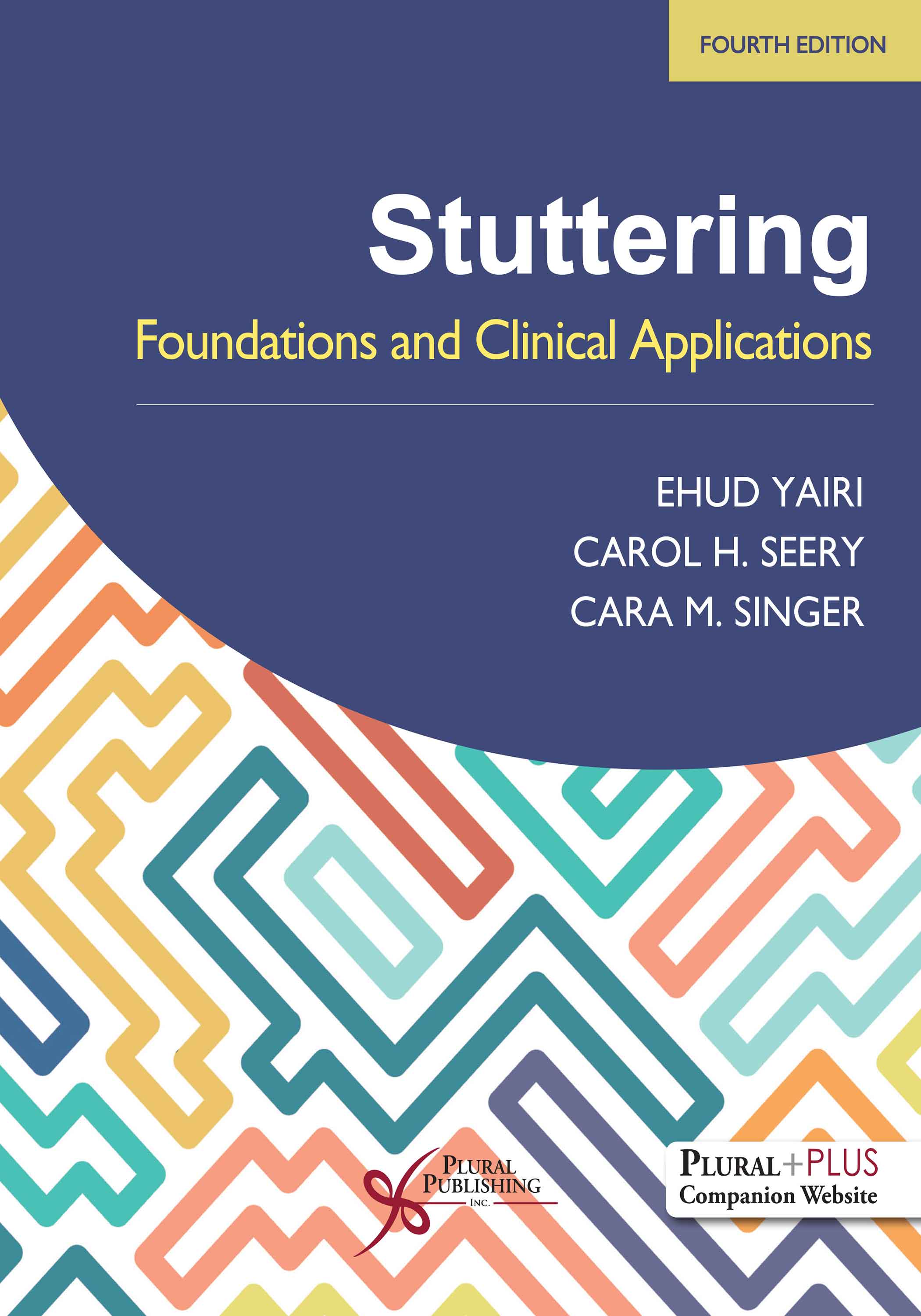
Stuttering: Foundations and Clinical Applications
Fourth Edition
Ehud Yairi, Carol H. Seery, Cara M. Singer
Details: 500 pages, B&W, Softcover, 8.5" x 11"
ISBN13: 978-1-63550-774-4
© 2027 | Coming Soon
Release Date: 09/01/2025


